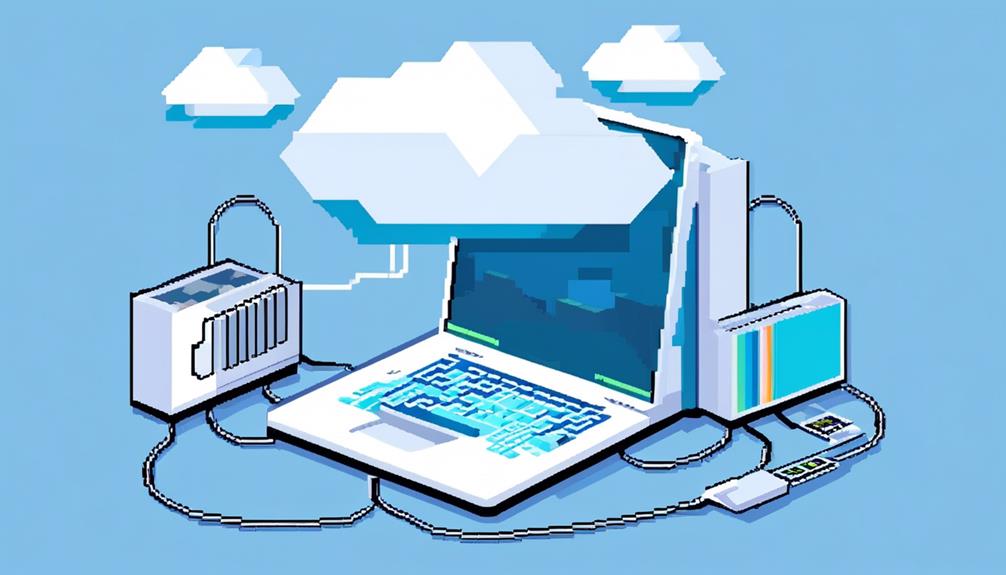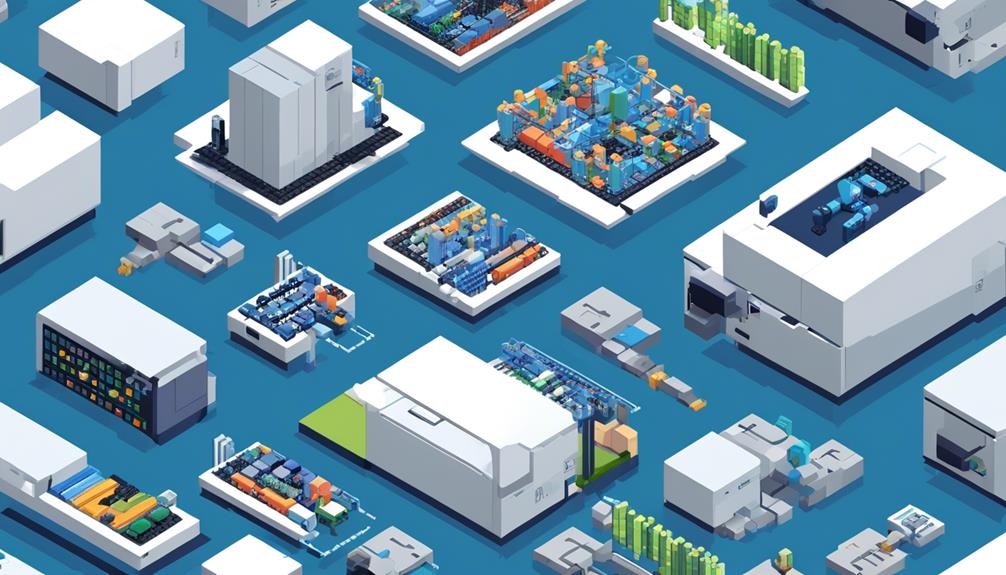In today's rapidly evolving digital landscape, businesses are increasingly turning to cloud computing to enhance their operations and drive innovation. However, selecting the right cloud-compatible hardware is a critical decision that requires careful consideration.
It is not simply a matter of picking the latest or most powerful hardware available. Instead, it involves a comprehensive assessment of various factors such as:
- Hardware compatibility
- Performance requirements
- Scalability options
- Security and compliance standards
- Management and automation tools
- Vendor support and reliability
- Integration with existing systems
- Data backup and disaster recovery capabilities
- Migration and transition planning
By taking these factors into account, businesses can ensure they make an informed decision that aligns with their unique needs and sets them up for success in the cloud.
Key Takeaways
- Hardware compatibility and performance are crucial considerations when choosing cloud-compatible hardware. It is important to evaluate compatibility with the selected cloud platform, hypervisor or virtualization technology used by the cloud provider, and different cloud services (IaaS, PaaS, SaaS). Limitations or restrictions imposed by the cloud provider should also be checked to ensure seamless integration and optimal performance within the cloud platform.
- Scalability options and cost-effective scalability should be considered when selecting cloud-compatible hardware. Vertical scaling, horizontal scaling, and global scaling options provided by the cloud provider should be explored to efficiently expand resources based on increasing demand. Choosing the right hardware and scalability approach is essential for cost efficiency and optimal performance.
- Security and compliance standards should be evaluated when choosing cloud-compatible hardware. Encryption, authentication, and backup methods should adhere to necessary security and compliance requirements. Data protection policies, encryption mechanisms for data protection in transit and at rest, and strong authentication mechanisms should be confirmed to prevent unauthorized access to cloud resources.
- Management and automation tools, cloud management platforms (CMPs), and orchestration and provisioning tools play a crucial role in centralized control, orchestration, and automation of cloud resources. These tools streamline provisioning, monitoring, and scaling of hardware resources in the cloud environment. Integration with DevOps tools, compatibility and integration capabilities with cloud-compatible hardware, and ensuring security and compliance standards are met are important considerations when evaluating these tools.
Hardware Compatibility

Hardware compatibility is a crucial aspect to consider when selecting and deploying devices for seamless integration and optimal performance within a cloud platform. It ensures that the chosen hardware devices can seamlessly integrate and function with the selected cloud platform. This involves evaluating the support for specific hardware components such as processors, memory modules, storage devices, and network interfaces.
One of the key considerations in hardware compatibility is verifying that the hardware is compatible with the hypervisor or virtualization technology used by the cloud provider. This is important to ensure seamless deployment and optimal performance. Different cloud providers may use different hypervisors or virtualization technologies, and compatibility with these technologies is essential for the hardware to function properly within the cloud platform.
Understanding the compatibility of hardware with different cloud services, such as Infrastructure as a Service (IaaS), Platform as a Service (PaaS), and Software as a Service (SaaS), is also crucial. Each of these services may have specific hardware requirements, and it is important to ensure that the selected hardware is compatible with the chosen cloud service.
Evaluating hardware compatibility also involves checking for any limitations or restrictions imposed by the cloud provider. These limitations may be related to specific hardware configurations or devices. It is important to be aware of these limitations to ensure that the selected hardware meets the requirements of the cloud platform.
Performance and Efficiency
After evaluating the hardware compatibility requirements, the next aspect to consider is the performance and efficiency of the selected hardware within the cloud platform.
Performance and efficiency are crucial factors that can significantly impact the overall effectiveness and cost-effectiveness of cloud computing. Here are three key considerations when assessing the performance and efficiency of cloud-compatible hardware:
- Evaluate the performance needs of your workloads: It is essential to assess the specific performance requirements of your workloads, including CPU, RAM, disk space, and network bandwidth. Understanding these needs will help you choose hardware that can handle the workload demands effectively.
- Compare customization and performance features of different cloud platforms: Different cloud platforms offer varying levels of customization and performance features. Take the time to compare these offerings to find the best fit for your needs. Look for platforms that provide robust performance monitoring and optimization tools to ensure optimal performance.
- Assess the geographical presence of cloud providers: The proximity of your chosen cloud provider's data centers to your target audience can have a significant impact on performance. Consider providers with data centers located near your target audience to reduce latency and improve overall performance.
In addition to these considerations, it is also crucial to explore modernization, optimization, and consolidation opportunities offered by cloud providers. These features can further enhance the performance and efficiency of your cloud environment. Additionally, consider the availability of ongoing support, community activity, and expertise when assessing the performance and efficiency of cloud services.
Scalability Options

When considering scalability options for cloud-compatible hardware, two key factors to consider are cost-effectiveness and seamless resource expansion.
Cost-effectiveness entails optimizing scalability solutions to ensure that the hardware resources can efficiently handle increased demand without incurring unnecessary expenses.
Seamless resource expansion involves the ability to smoothly add new hardware resources, such as virtual machines, to distribute the workload and improve performance without causing disruptions or downtime.
Cost-Effective Scalability
Cloud providers offer a variety of cost-effective scalability options, allowing users to efficiently adjust resources according to their needs and avoid wasteful provisioning or underutilization of hardware. When choosing cloud-compatible hardware, it is essential to consider the scalability options provided by the cloud provider. Here are three key factors to consider:
- Vertical scaling: This option allows users to increase resources within a single server, such as adding more memory or processing power. It is suitable for applications that require more resources but do not need to distribute the load across multiple servers.
- Horizontal scaling: With this option, users can add more servers to distribute the workload. It is ideal for applications that need to handle a high volume of traffic and require load balancing.
- Global scaling: This option allows users to expand their resources across multiple regions, providing redundancy and improving performance for users in different geographical locations.
Seamless Resource Expansion
To seamlessly expand resources in cloud environments, it is crucial to explore the scalability options available for efficient resource expansion. Cloud providers offer various scalability options to meet changing demand.
Vertical scaling involves increasing the capacity of existing hardware, while horizontal scaling entails adding more hardware to distribute the load. Cloud providers also offer automatic scaling options based on predefined triggers or manual adjustments to accommodate varying workloads.
When evaluating scalability options, factors such as ease of implementation, impact on performance, and alignment with business needs must be considered. Choosing the right hardware and scalability approach is essential for cost efficiency and optimal performance in resource expansion.
Security and Compliance Standards
Evaluation of encryption, authentication, and backup methods is crucial for ensuring adherence to security and compliance standards in cloud-compatible hardware. When considering cloud-compatible hardware, it is essential to verify if the cloud platforms meet the necessary security and compliance requirements. This involves assessing the data protection policies and practices of cloud providers and ensuring they align with the necessary regulations and standards.
To ensure security and compliance, here are three important factors to consider:
- Data Encryption: Encryption is a fundamental aspect of securing data in the cloud. It ensures that sensitive information remains unreadable to unauthorized individuals. When evaluating cloud-compatible hardware, it is important to confirm that encryption mechanisms are in place to protect data both in transit and at rest.
- Authentication Mechanisms: Strong authentication mechanisms are vital for preventing unauthorized access to cloud resources. When selecting cloud-compatible hardware, it is crucial to assess the availability and effectiveness of authentication methods such as multi-factor authentication (MFA) or biometric authentication.
- Backup and Recovery: Robust backup and recovery mechanisms are essential to safeguard data and ensure business continuity. When choosing cloud-compatible hardware, it is important to evaluate the backup and recovery capabilities offered by the cloud provider. This includes assessing factors such as backup frequency, recovery time objectives (RTOs), and the ability to restore data in the event of a disaster.
In addition to evaluating encryption, authentication, and backup methods, it is also important to consider the location and jurisdiction of the cloud provider. Different countries have varying security and compliance standards, so it is crucial to ensure that the chosen cloud provider operates within the desired jurisdiction and complies with the necessary regulations.
Management and Automation Tools

Management and automation tools play a crucial role in optimizing cloud infrastructure. These tools provide centralized control and orchestration of virtual machines, containers, and infrastructure components.
They enable streamlined provisioning, monitoring, and scaling of hardware resources, enhancing operational efficiency and agility in the cloud environment.
Tools for Cloud Automation
Cloud automation is a critical component of efficient and streamlined cloud infrastructure management. To achieve this, organizations rely on a variety of tools specifically designed for cloud automation.
These tools offer a range of features that automate and manage cloud infrastructure, ensuring optimal resource utilization, cost management, and scalability. Some key features of these tools include template-based configuration, policy-driven automation, and integration with DevOps tools.
By leveraging these management and automation tools, organizations gain visibility into their cloud environments, automate repetitive tasks, and ensure compliance with security and governance policies.
Cloud Management Platforms
To seamlessly manage and automate cloud resources, organizations turn to Cloud Management Platforms (CMP) – an integral component of efficient cloud infrastructure management.
CMPs provide centralized management and automation tools for cloud resources, helping organizations assess and provision the required number, type, and size of virtual machines. These platforms also evaluate and compare the customization and performance features of different cloud providers, assisting organizations in choosing cloud-compatible hardware.
In addition, CMPs play a crucial role in ensuring security and compliance standards are met through encryption, authentication, and backup methods. They offer ongoing assistance through community support, resources, and expertise, helping organizations optimize their cloud infrastructure.
When choosing cloud-compatible hardware, considering the compatibility and integration capabilities of the hardware with the chosen CMP is essential.
Orchestration and Provisioning
Orchestration and provisioning tools streamline the configuration, deployment, and scaling of cloud resources, enhancing operational efficiency. These tools automate the arrangement, coordination, and management of complex computer systems, services, and workflows in the cloud.
They also automate the deployment and management of infrastructure resources, such as virtual machines, storage, and networks, in the cloud environment. By enabling efficient resource allocation and utilization, these tools reduce manual intervention and enhance scalability.
Additionally, orchestration and provisioning tools facilitate the automation of repetitive tasks, ensuring consistency and reliability in managing cloud infrastructure.
When choosing cloud-compatible hardware, it is essential to consider the compatibility and integration of these tools with the hardware, as they play a crucial role in effectively managing and automating the infrastructure provided by the cloud provider.
Cost and Pricing Considerations

When evaluating pricing models for cloud hardware, it is crucial to understand the total cost of ownership (TCO). This involves considering not only the upfront costs of purchasing the hardware, but also the ongoing expenses associated with its operation and maintenance. Cloud-compatible hardware offers a range of cost and pricing considerations that businesses need to take into account when choosing a cloud provider.
One important factor to consider is the pricing structure offered by the cloud provider. Different providers may offer different models, such as pay-as-you-go or reserved instances. Pay-as-you-go pricing allows businesses to pay for the resources they use on a per-hour or per-minute basis, providing flexibility and scalability. Reserved instances, on the other hand, require a commitment for a specific period of time, but can offer significant cost savings for long-term workloads.
In addition to the pricing structure, it is essential to evaluate the additional costs associated with cloud-compatible hardware. These can include data transfer fees, storage fees, and other charges that can significantly impact the overall pricing. It is important to carefully assess these costs across different cloud providers to make an informed decision.
To optimize costs, businesses should also consider implementing cost optimization strategies. This involves analyzing resource utilization, identifying areas of inefficiency, and making adjustments to ensure efficient use of cloud hardware resources. By optimizing costs, businesses can maximize their return on investment and reduce unnecessary expenses.
Vendor Support and Reliability
In order to ensure a seamless transition to cloud-compatible hardware, businesses must carefully evaluate the vendor's support and reliability to address any potential issues and maintain a consistent level of service.
When choosing a cloud provider, there are several key factors to consider:
- Evaluate the cloud provider's track record in resolving customer issues and responsiveness of technical support. It is crucial to assess the provider's ability to promptly address any hardware-related concerns that may arise. Look for a vendor with a proven history of excellent customer support and quick response times.
- Consider the availability and reliability of support channels, such as phone, email, or live chat. In times of technical difficulties, having multiple support channels available can be crucial. Ensure that the vendor offers a range of support options to cater to your specific needs. It is also important to verify the availability of support during critical times, such as weekends or holidays.
- Assess the provider's documentation, knowledge base, and community forums for ongoing assistance. A reliable vendor should provide comprehensive documentation and a knowledge base that covers all aspects of their hardware offerings. Additionally, a vibrant community forum can be a valuable resource for troubleshooting and sharing best practices. By leveraging these resources, businesses can minimize downtime and quickly resolve any hardware-related issues.
Integration and Compatibility With Existing Systems

When considering the integration and compatibility of cloud-compatible hardware with existing systems, there are several points to consider.
Firstly, system integration challenges may arise, requiring careful assessment and planning to ensure a smooth transition.
Secondly, evaluating existing software compatibility is crucial to avoid any disruptions or compatibility issues.
Lastly, seamless cloud integration is essential, requiring the evaluation of available APIs and integration capabilities for interoperability with existing infrastructure.
System Integration Challenges
Assessing compatibility with existing systems and applications is a crucial step in ensuring seamless integration into the cloud environment. Organizations need to carefully evaluate their hardware needs and consider the system integration challenges they may face when migrating to the cloud.
Here are three important factors to consider:
- API and integration capabilities: Assessing available APIs and integration capabilities can help determine the ease of integrating with existing systems. Organizations should look for cloud-compatible hardware that offers robust integration options.
- Support for hybrid cloud environments: Many organizations have a mix of on-premises and cloud-based systems. It is essential to choose hardware that supports hybrid cloud environments, allowing for seamless integration between the two.
- Migration and data transfer ease: Evaluating the ease of migration and data transfer is crucial in assessing the effort required to integrate with existing systems. Choosing hardware that simplifies data migration can significantly reduce the integration challenges.
Existing Software Compatibility
To ensure a seamless integration into the cloud environment, organizations must carefully evaluate the compatibility of their existing systems and applications with potential cloud providers.
This assessment involves considering the hardware and software requirements of the cloud provider and comparing them with the organization's existing infrastructure.
Compatibility with the cloud environment can be achieved through the availability of APIs and integration capabilities that allow for the smooth integration of existing systems.
Additionally, support for hybrid cloud environments is crucial to ensure interoperability between on-premises and cloud-based systems.
During the transition to the cloud, it is essential to evaluate the ease of migration and data transfer to minimize disruptions.
Lastly, organizations should assess the risks of vendor lock-in to maintain flexibility and avoid limitations with their existing systems.
Seamless Cloud Integration
Achieving seamless integration with existing systems is crucial for ensuring smooth data flow and efficient operation within the cloud environment.
When choosing cloud-compatible hardware, it is essential to evaluate its compatibility and interoperability with current hardware, software, and applications.
Consideration should be given to the support for hybrid cloud environments and the ease of migration for existing workloads.
Additionally, it is important to assess the available APIs and integration capabilities of the hardware to connect with existing systems and tools.
Another factor to consider is the risk of vendor lock-in and the ability to transfer data and workloads between the cloud and on-premises systems.
Data Backup and Disaster Recovery

Data backup and disaster recovery are critical components of ensuring the continuity and security of business operations. Organizations have various options for data backup, including on-premises, cloud-based, and hybrid solutions. These options provide redundancy and disaster recovery capabilities to safeguard against data loss or system failures.
To establish effective data backup strategies, organizations must define data retention policies. These policies determine the frequency and duration of backups, aligning with recovery point objectives (RPO) and recovery time objectives (RTO). RPO specifies the maximum tolerable amount of data loss, while RTO determines the acceptable downtime before normal operations can be resumed.
Data security is paramount when it comes to backup solutions. Implementing encryption, access controls, and authentication methods protects backed-up data from unauthorized access or breaches. These security measures ensure the integrity and confidentiality of the data throughout the backup and recovery process.
Automation plays a crucial role in backup and recovery processes. By automating these tasks, organizations can streamline operations and minimize downtime in the event of a disaster or data loss. Automated backups can be scheduled at regular intervals, ensuring that critical data is consistently backed up without manual intervention.
Evaluating the performance and reliability of backup solutions is essential to guarantee effective data restoration and system recovery in case of a disaster. Organizations should assess the backup solution's ability to restore data and systems efficiently and reliably, taking into account factors such as backup speed, restoration time, and scalability.
Migration and Transition Planning
The successful migration and transition to cloud-compatible hardware require careful assessment of hardware requirements, security and compliance standards, compatibility with existing infrastructure, geographical presence, and community support.
To ensure a smooth transition, hardware professionals should consider the following:
- Assessing hardware requirements: Before migrating to cloud-compatible hardware, it is crucial to evaluate the specific hardware requirements, such as CPU, RAM, disk space, and network bandwidth. By understanding these requirements, organizations can choose the most suitable cloud provider that can meet their needs.
- Evaluating security and compliance standards: Security is a top concern when it comes to migrating to the cloud. Hardware professionals must thoroughly evaluate the security and compliance standards offered by cloud providers. This includes assessing encryption methods, authentication protocols, backup mechanisms, and data protection policies to ensure the safety and privacy of sensitive information.
- Ensuring compatibility with existing infrastructure: Compatibility with existing infrastructure is essential for a seamless transition. Hardware professionals need to consider factors such as hypervisors, networking capabilities, and backup and disaster recovery options. Ensuring compatibility will minimize disruptions and allow for a more efficient migration process.
Frequently Asked Questions
What Hardware Is Needed for Cloud Computing?
Hardware requirements for cloud computing include:
- CPU
- RAM
- Disk space
- Network bandwidth
Cloud compatible hardware options vary depending on the specific needs of the cloud computing environment.
When selecting cloud compatible hardware, key considerations include:
- Scalability
- Performance
- Cost
- Compatibility with chosen hypervisors such as VMware, Hyper-V, or KVM.
It is crucial to assess:
- The number, type, and size of virtual machines needed
- Evaluate operating systems and applications to be run
- Compare customization and performance features of different cloud platforms.
How Do You Choose a Cloud Platform for Hardware Virtualization?
To choose a cloud platform for hardware virtualization, several factors must be considered.
First, it is important to understand the benefits of hardware virtualization in cloud computing, such as increased flexibility and resource utilization.
Second, steps should be taken to ensure compatibility between the hardware and the chosen cloud platforms, including evaluating encryption, authentication, and backup methods for security compliance.
What Are the Factors to Be Considered Before Selecting a Cloud Platforms?
Before selecting a cloud platform, several factors need to be considered. These include:
- Cost considerations: It is important to evaluate the pricing structure of the cloud platform, ensuring it aligns with the organization's budget.
- Scalability requirements: Scalability options should be assessed to ensure the platform can accommodate future growth.
- Security and compliance needs: Security and compliance standards should be thoroughly evaluated, including encryption, authentication, and data protection policies, to ensure the platform meets the organization's requirements.
What Factors Need to Be Taken Into Consideration When Choosing a Device to Connect to Cloud Services?
When choosing a device to connect to cloud services, there are several factors to consider.
First and foremost is data security, as the device must have robust security measures in place to protect sensitive information.
Network connectivity is also crucial, as the device should have reliable and fast connectivity to ensure smooth access to cloud services.
Additionally, device compatibility is important, as it should be able to seamlessly integrate and interact with the chosen cloud platform.
